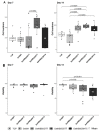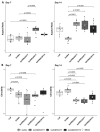Equine Tenocyte Seeding on Gelatin Hydrogels Improves Elongated Morphology
- PMID: 33670848
- PMCID: PMC7957613
- DOI: 10.3390/polym13050747
Equine Tenocyte Seeding on Gelatin Hydrogels Improves Elongated Morphology
Abstract
(1) Background: Tendinopathy is a common injury in both human and equine athletes. Representative in vitro models are mandatory to facilitate translation of fundamental research into successful clinical treatments. Natural biomaterials like gelatin provide favorable cell binding characteristics and are easily modifiable. In this study, methacrylated gelatin (gel-MA) and norbornene-functionalized gelatin (gel-NB), crosslinked with 1,4-dithiotreitol (DTT) or thiolated gelatin (gel-SH) were compared. (2) Methods: The physicochemical properties (1H-NMR spectroscopy, gel fraction, swelling ratio, and storage modulus) and equine tenocyte characteristics (proliferation, viability, and morphology) of four different hydrogels (gel-MA, gel-NB85/DTT, gel-NB55/DTT, and gel-NB85/SH75) were evaluated. Cellular functionality was analyzed using fluorescence microscopy (viability assay and focal adhesion staining). (3) Results: The thiol-ene based hydrogels showed a significantly lower gel fraction/storage modulus and a higher swelling ratio compared to gel-MA. Significantly less tenocytes were observed on gel-MA discs at 14 days compared to gel-NB85/DTT, gel-NB55/DTT and gel-NB85/SH75. At 7 and 14 days, the characteristic elongated morphology of tenocytes was significantly more pronounced on gel-NB85/DTT and gel-NB55/DTT in contrast to TCP and gel-MA. (4) Conclusions: Thiol-ene crosslinked gelatins exploiting DTT as a crosslinker are the preferred biomaterials to support the culture of tenocytes. Follow-up experiments will evaluate these biomaterials in more complex models.
Keywords: cell proliferation; gel fraction; gelatin; hydrogels; morphology; storage modulus; swelling ratio; tenocytes; viability.
Conflict of interest statement
The authors declare no conflict of interest.
Figures







Similar articles
-
Additive manufacturing of photo-crosslinked gelatin scaffolds for adipose tissue engineering.Acta Biomater. 2019 Aug;94:340-350. doi: 10.1016/j.actbio.2019.05.062. Epub 2019 May 25. Acta Biomater. 2019. PMID: 31136829
-
Thiol-norbornene gelatin hydrogels: influence of thiolated crosslinker on network properties and high definition 3D printing.Biofabrication. 2020 Dec 31;13(1). doi: 10.1088/1758-5090/abc95f. Biofabrication. 2020. PMID: 33176293
-
An adhesive and injectable nanocomposite hydrogel of thiolated gelatin/gelatin methacrylate/Laponite® as a potential surgical sealant.J Colloid Interface Sci. 2020 Mar 22;564:155-169. doi: 10.1016/j.jcis.2019.12.048. Epub 2019 Dec 26. J Colloid Interface Sci. 2020. PMID: 31911221
-
Modular Cross-Linking of Gelatin-Based Thiol-Norbornene Hydrogels for in Vitro 3D Culture of Hepatocellular Carcinoma Cells.ACS Biomater Sci Eng. 2015 Dec 14;1(12):1314-1323. doi: 10.1021/acsbiomaterials.5b00436. Epub 2015 Oct 29. ACS Biomater Sci Eng. 2015. PMID: 33429678
-
Quantification of fractional and absolute functionalization of gelatin hydrogels by optimized ninhydrin assay and 1H NMR.Anal Bioanal Chem. 2020 Sep;412(24):6211-6220. doi: 10.1007/s00216-020-02792-5. Epub 2020 Jul 3. Anal Bioanal Chem. 2020. PMID: 32617761 Free PMC article.
Cited by
-
Design of an electrospun tubular construct combining a mechanical and biological approach to improve tendon repair.J Mater Sci Mater Med. 2022 May 31;33(6):51. doi: 10.1007/s10856-022-06673-4. J Mater Sci Mater Med. 2022. PMID: 35639212 Free PMC article.
-
Bioresorbable Chitosan-Based Bone Regeneration Scaffold Using Various Bioceramics and the Alteration of Photoinitiator Concentration in an Extended UV Photocrosslinking Reaction.Gels. 2022 Oct 28;8(11):696. doi: 10.3390/gels8110696. Gels. 2022. PMID: 36354604 Free PMC article.
-
The Lack of a Representative Tendinopathy Model Hampers Fundamental Mesenchymal Stem Cell Research.Front Cell Dev Biol. 2021 May 3;9:651164. doi: 10.3389/fcell.2021.651164. eCollection 2021. Front Cell Dev Biol. 2021. PMID: 34012963 Free PMC article. Review.
-
Orthogonally Crosslinked Gelatin-Norbornene Hydrogels for Biomedical Applications.Macromol Biosci. 2024 Feb;24(2):e2300371. doi: 10.1002/mabi.202300371. Epub 2023 Oct 6. Macromol Biosci. 2024. PMID: 37748778 Free PMC article. Review.
References
-
- Burk J. Tendons. IntechOpen; London, UK: 2019. Mechanisms of Action of Multipotent Mesenchymal Stromal Cells in Tendon Disease.
Grants and funding
LinkOut - more resources
Full Text Sources
Other Literature Sources

